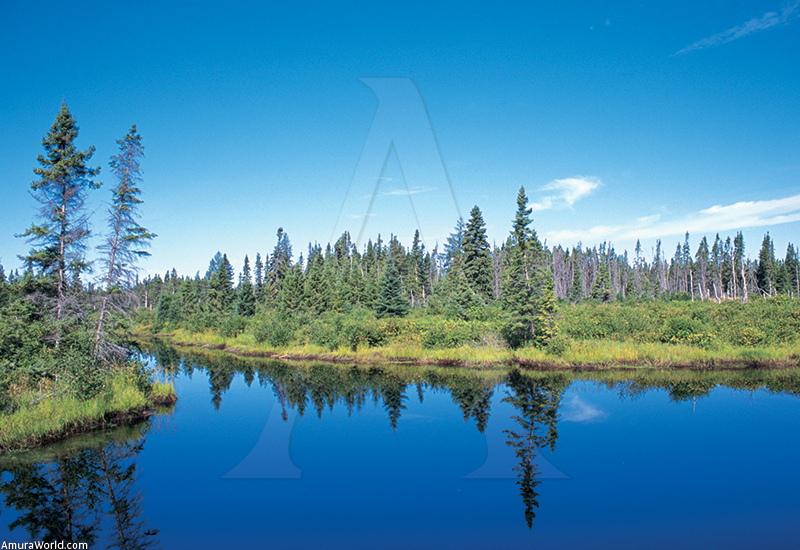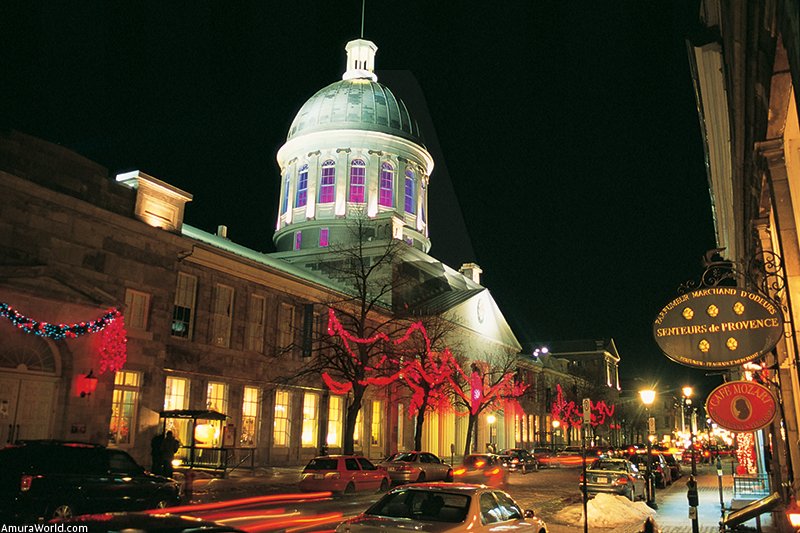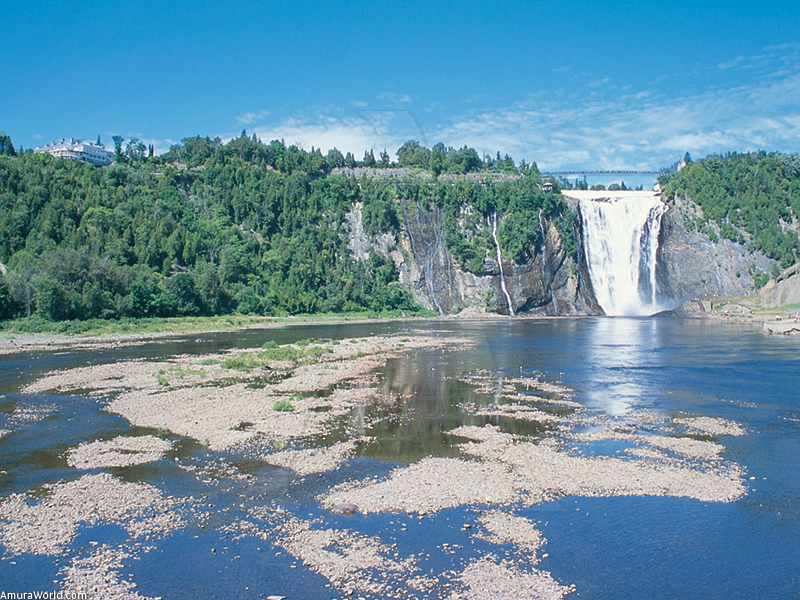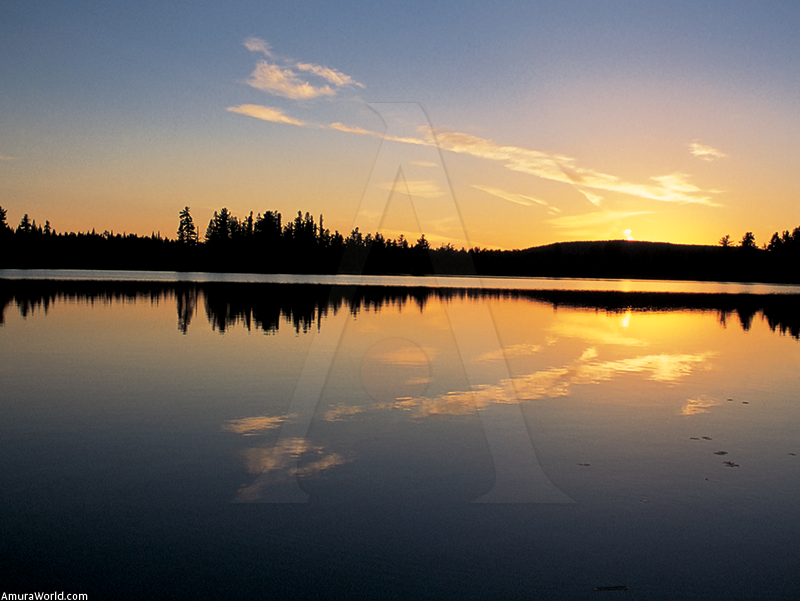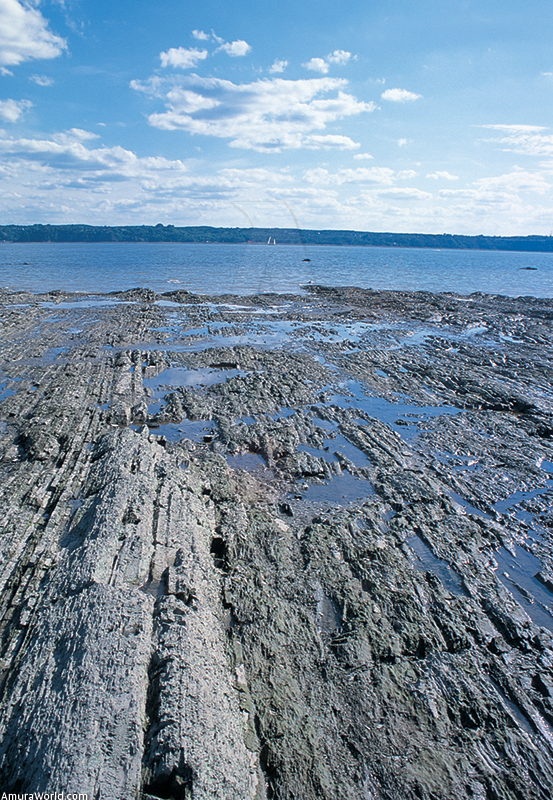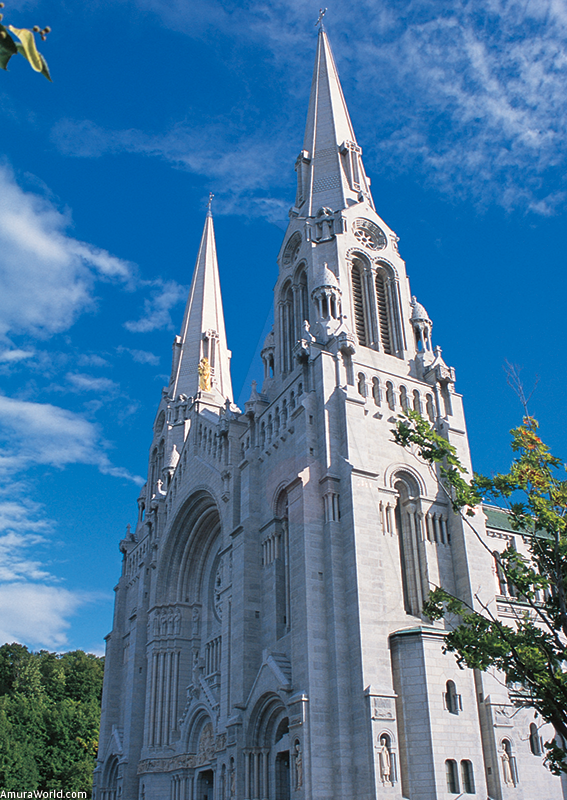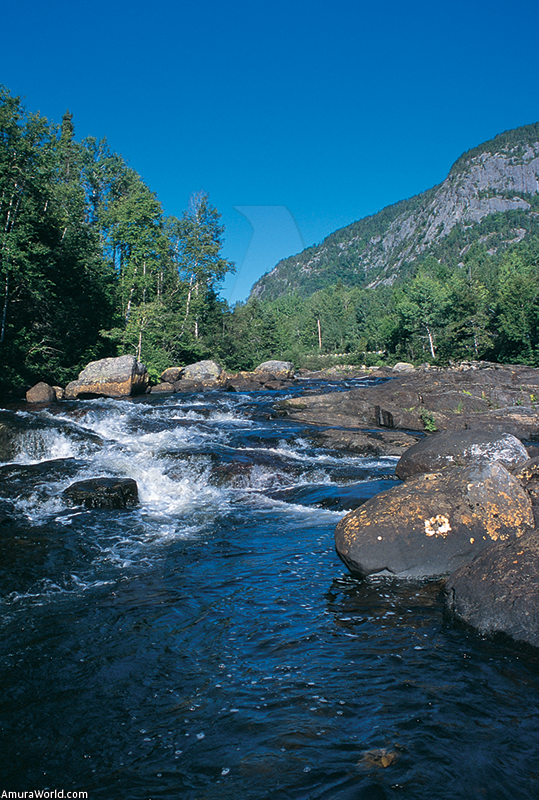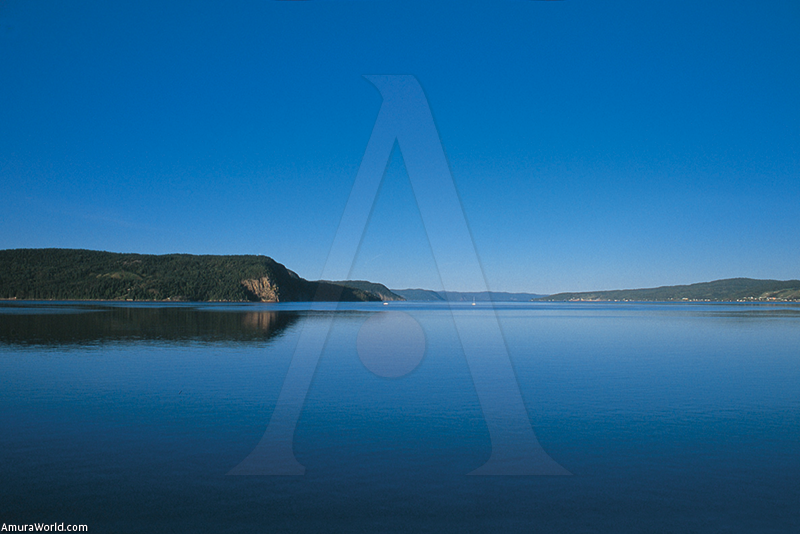Along the Saint Laurent River , from Montreal to Tadoussac
The great river comes from far away, crosses the great lakes and travels through the hills of Quebec before becoming an enormous estuary. It is the true artery of a region that has a long winter but when the days become warmer it is a river filled with life: “Je suis une mer qui vit dans la terre” (I am an ocean that lives on the land) and the Saint Laurent has its own unique flora and fauna. Starting in May the ice disappears and allows navigation, the whales arrive in Tadoussac and the summer paints the hills green. The tides can be felt all the way to Trois Rivières, almost 1,300 kilometers (808 miles) inland. It is an amazing thing to see how the ice floes rise and fall to the rhythm of the tides, especially from the Dufferin Terrace in the city of Quebec.
From Montreal to Quebec
Montreal is a surprising, fascinating city whose fond historic memories are blended into the metropolis: it is clothed in modernity but in its heart it conserves the old stones of its past. Dominated by the elegant Hôtel de Ville, the Jacques Cartier plaza bursts with restaurants and shops, pedestrians and street artists. Notre Dame's high towers guard the buildings from the beginning of the 20^ century. The cobblestone streets of the Vieux Quartier attract as do its houses from the past, such as the Maison Pierre du Calver and the Chateau Ramezay, built in 1705, as well as the Bonsecours market and the Notre Dame de Bonsecours chapel. The footsteps of time echo on the paving stones of the rue Saint Paul, crowded with restaurants, bars and shops and, in the Les 2 Pierrots bar, the nights are warmed up by the rhythm of the unrestrained musicians and spectators.
The me Sainte Catherine vibrates with its crowds, shopping centers, the renowned jeweler Birks and the famous Ogilvy store. The me Mackay, me Crescent and the Boulevard du Saint Laurent are the places to be and the me Saint Denis beats to the rhythm of its theaters, movie houses and cafes. The museums exhibit history and art the Olympic Stadium’s amazing architecture is located near the botanical garden, with its 30 different sections; and Mont Royal, an admirable forest that beckons with the flavors of each season, dominates the city. Montreal has a magic that enchants.
Montreal is a bona fide port with several marinas and we decided to use the boat’s engine on the long trip to the city of Quebec, without stopping in the towns that adorn the banks of the Saint Laurent, passing Trois Rivières, where the current of the tide helped us.
In Quebec, the tides are very important even though they are 1,000 kilometers (621 miles) inland. The access to the Yacht Club is done using them or by the sluice which, fed by the Charles River, permits the port to always be at the same level.
Quebec is the charm of its streets that wind their way along the hill, framed by beautiful ancient houses that are 400 centuries old. It is the sumptuous view from the Dufferin terrace, at the foot of the impressive Château Frontenac and the Citadelle, the fort that dominates the city. It is the Ville Basse, a string of streets, small plazas and hidden stairways that invite you to stroll around and listen to the sounds of summer life or the silence of winter nights, when the snow blankets the area. It is an entertaining city overflowing with bars, “boites a Chanson”, traditional French restaurants, maple syrup, its Inuit museum and historic sites that preserve the aroma of France.
In 1535 Jacques Cartier stopped in the town of Stadacomê. which later became Quebec, located at the foot of a great rock that he christened Cap Diamant. Due to the boom in the fur trade, in 1608 Samuel de Champlain built homes and. little by little. French merchants settled there, creating the Ville Basse, a trade center, while the Ville Haute, built on the rock, was where the religious institutions where located. Disputed by France and England, the Treaty of Paris of 1763 made Quebec formally English though the inhabitants remained French.
From Québec to the island of Orleans
The Island of Orleans (lie d'Orleans) is located in front of the city of Quebec and we reached it after a short sail during which we enjoyed the beautiful view of the city and the island, a real floating garden where the apples compete in beauty with the towns adorned with flowers of the season. We docked at the Saint Laurent de Llle marina and toured the island and its peaceful towns caressed by the rhythm of the tides on bicycle. Here, "Il y a des maisons où les chansons aiment entrer”. (There are houses were songs like to enter) sang Felix Leclerc and in the terrace of the Auberge de Chaumonnot we enjoyed its charm with a Blanccassis while the seagulls keep a look out for the traditional fragrant bread that comes out of the ovens of La boulange in Saint Jean. The past is present in the ancient naval shipyards that built goélettes, boats that were used for trade, and in the Chalouperie they still construct the small boats from long ago.
From the island of Orleans to Baie Saint Paul
lb sail on the great river you must consult a detailed marine map and know the hours of the tides that either help or hinder with their strong currents and leave anchor spots high and dry. We have to follow the navigation channels where the water is deep enough and. with the tides, reach the port
A short navigation, helped by the calm winds encountered in the middle of the river, while a total calm is found on the banks, took us to Baie Saint PauL a charming town with houses whose windows are adorned with flowers and which is located at the end of a bay that, at low tide, is emptied of its waters. Hidden at the bottom of the valley of the Du Gouffre River, which flows into the Saint Laurent it was. in 1678. one of the first settlements of the region. It is an extraordinary, romantic capsule where the MocroBrasserie of Charlevoix, the producer of Quebec's finest beer, is found. It is also a town that sings in the shade of its bell tower, a place where you can visit the galleries on the Saint Chapelle street and the Economusêe du fromage to sample the cheese.
From Baie Saint Paul to La Malbaie
Playing with the tides and the wind, we neared the llle au Coudre, a striking island of beautiful meadows. chapels and water and windmills that we toured on bicycle. We remembered that, since 1710 and in its heyday, the islanders made a living by whale hunting. Oil was extracted mainly from belugas. melted and used in oil lamps. We stopped in Saint Joseph de la Rive to visit the ancient arsenal where “goélettes”, those beautiful boats used for fishing and cargo where built. They have flat bottoms so that they can run aground on the sand without inclining when the tide recedes. The wood of these old boats is worn and many holes have appeared on their bodies. They are like wounds made by the sea in ancient gashes.
We followed a coast of green hills that descend towards the great river, shinning in the reflected sunlight and dotted with white and colorful houses with blue, red and purple windows, such as the town of Sainte Irene, affectionately chosen by painters. The names of the places evoke the adventures of the first settlers: Cap aux Oies (Cape of the Geese). Les Éboulements (The Cave Ins) and Pointe au Pic (Point of the Peak), where there are several beautiful houses dominated by the Manoir Richelieu, an impressive hotel built in 1929. Finally, we reached La Malbaie. hidden at the end of a bay at the end of the Malbaie Rivers “Haute Gorges" canyon. In 1608. Samuel de Champlain docked his ships in this well sheltered bay. The next morning the ships were stranded on the sand and Champlain said, “Ha. la malle baye", calling the place “the bad bay”. This is how one of Charlevoix’s most beautiful bays was named.
We took advantage and explored the region, admiring the beautiful view from the Belvédère, passing towns lost in time such as Saint Urban and discovered an enormous crater caused by the impact of an massive meteorite 350 million years ago. It is an impressive scene covered by boreal forest where the Des Jardins National Park is located. It encompasses 350 square kilometers (135 square miles) of beautiful paths perfect for hiking in the tundra. The Des Hautes Gorges de la Rivière Malbaie Regional Park is a canyon ideal for rafting. La Malbaie invites one to enjoy its excellent restaurants, golf and social life.
From La Malbaie to Tadoussac
When we left La Malbaie we reached Cap à L'Aigle, where elegant houses are hidden in the forest, and we sailed in a sea kayak to observe whales and seals. The mountains sink into the river.
We passed Port au Persil, a charming village straight out of a storybook, with its small church with a white steeple, where we found two whales. Saint Simeón is a picturesque port lying on a hillside and the spot where the ferry that joins the coast of Charlevoix with Rivière du Loup, on the south border of the Saint Laurent, docks. We arrived in Baiedes Rochers, a spectacular bay that forms a natural port and where the uneven mountains seem to escort their forests to the sea. At the foot of the cliff, Baie Sainte Marie throbs when the afternoon light illuminates its bell tower and lives to the constant activity of the ships that take people to admire the whales. Passing Pointe Noire and its dizzying cliffs we discovered the great cut of the Saguenay fiord, a maritime route created millions of years ago by the glaciers, where we reached the marina in Tàdoussac, a small town dominated by the red roof of its hotel.
This privileged place was where, in 1600, the first French encampment was settled. Dedicated to the fur trade, it was established eight years before the foundation of the city of Quebec. Set in a spectacular place, its Chapelle des Indiens, built in 1747, is the oldest religious wood building still standing today in Canada. The entrance to the fiord is a place favored by beluga whales, which nourish themselves with what is brought in by the tides that enter the Saguenay River, where the salt water floats on the surface of the fresh river water that descends from the Saint Jean Lake. In the waters of the Saint Laurent we saw beluga, common rorqual, hunchback and sperm whales as well as seals.
From Tadoussac to La Baie
Sailing on the Saguenay has to be done with a motor due to the fact that the wind rarely passes the cliffs, sculpted by the ancient glacier, that frame it. It is a disconcerting journey that allows you to discover the series of bays nestled at the bottom of stunning wooded valleys with names that bring to mind the times when the “truchements". the hunters that traversed these mountains, lived with the natives, acting in a quite brutish way: one of them Etienne Brute, a true legend of the past, died at the hands of his friends, the Hurons.
Some unique nooks and crannies animate the fiord: L’Anse Saint Jean. a sleepy town with a covered bridge hidden in a beautiful bay; Rivi6re £ter nit&, where the forest caresses the transparent waters and a paradise for fishing aficionados and fauna watchers and Sainte Rose du Nord. a story book town forgotten by time, enveloped in its green fields and the waters of the Saguenay River.
Finally, we reached La Baie, a city located at the end of the fiord, in the Ha Ha Bay and at the end of the navigable part where it is amazing to find great ships anchored so far inland. La Baie. renowned for its cuisine, dazzles at night when it is reflected in the water. Salmon crisscross its waters and later swim up the rapids to reach the depths of the Saint Jean Lake, a true inland ocean measuring 1,200 square kilometers (463 square miles) that enjoys moderate winds and has several marinas on its banks such as Alma, Roberval and Peribonka. There is no navigable communication between the Saguenay fiord and the Saint Jean Lake, where the water has a temperature of 20 °C (68 °F) while that of the Saint Laurent barely reaches 4 °C (39 °F). and the water passes through falls like the Chicoutimi before the influence of the tides cools it down.
From La Baie to Montreal.
We returned to Montreal by road and discovered the marvelous landscape of Quebec, covered by forests, sown with navigable lakes, packed with rivers and waterfalls and adorned by parks where caribou, wolves, beavers, moose, fox and geese live. The towns are attractive, the cuisine is enchanting, the warmth of the people charms and the scenery is magical.
The banks of the great Saint Laurent River beat to the rhythm of its tides and its towns and cities, islands and hills are reflected in its waters navigated by great boats. Quebec is a charming garden that resides near this sea that is not really a sea and festooned with the sailboats and goélettes that play with the tides to avoid getting stranded in the mud. It is a country that seems to rise from a dream, sleeping in winter and dazzling in summer. The river is a warm, natural poem dedicated to unique Quebec, a place that ought to be discovered.
Text: Patrick Monney ± Photo: Patrick Monney

